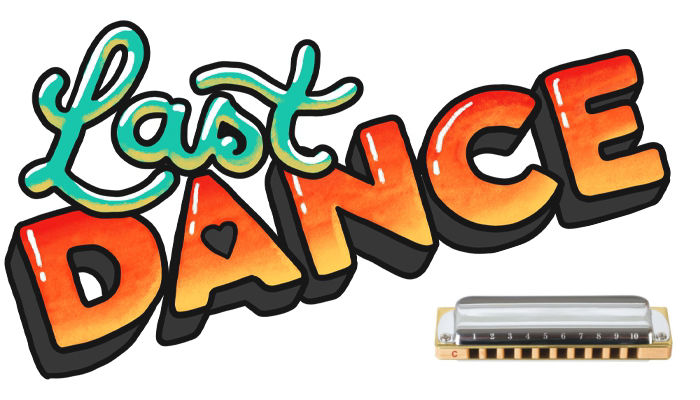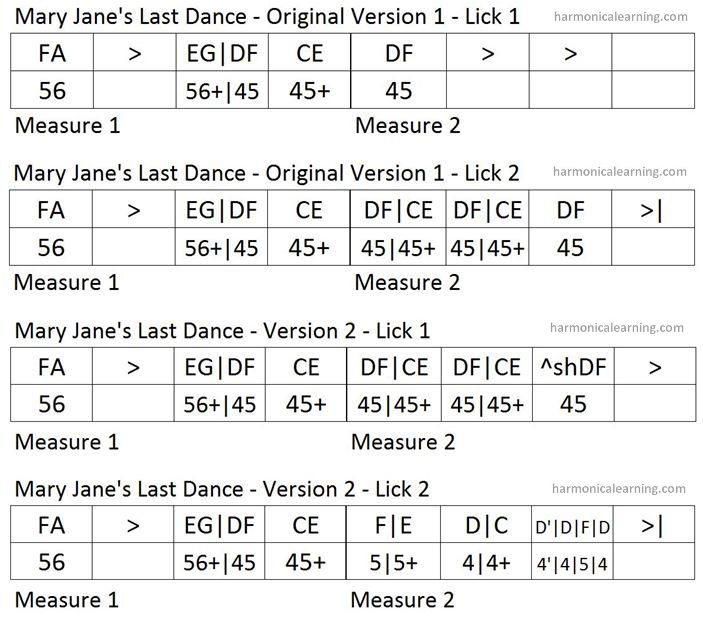
When one of my students from the UK asked me to create a lesson on the harmonica part in Mary Jane’s Last Dance, I thought: “Here we go again, I’m going have to come up with something to build a whole practice session on a couple of musical licks." Certainly Tom Petty, with this song, ended up at number 14 on the Billboard Hot 100, and in the Top 20 of the 90s. However, I appreciated this track more for the guitars and the singing than for the harmonica part, was is pretty limited. As always, since I love playing the harmonica with any musical genre, I accepted the work and analyzed Mary Jane’s Last Dance from both the harmonica and melodic point of view.
To follow this lesson, you’ll need a C harmonica. It’s the key I decided to adopt here because most beginner players don’t own a G instrument. The original song key is in A minor, and it’s played in third position on a G harmonica. For the purpose of this study session, you’ll play in D minor in the same position (third) on a D minor backing track. As far as the videos are concerned, below, you’ll find the play-along and the backing track, both with on-screen tabs and the slow version. You can also download the tabs and work on your own with whatever harmonica key you have.
What else are you going to learn today? For those of you who have been following me for a while, I’m pretty sure you’re expecting something more from my lesson – and here it is. Together with the main Mary Jane’s Last Dance harmonica licks, I wanted to give you something more interesting to study, so I created two variations of them, as well as a more challenging improvised version. This lesson is intended for beginner harmonica players, but even intermediate students will gain some benefit from studying it.
Let’s start and have a look at the simple harmony progression with which the harmonica is played. These are the chords:
Dm, C, Gsus2, D.
That’s it. Yes, once again, this demonstrates that in order to produce music with a big impact, you don’t need to invent complicated things, but rather engage in simple stuff that everyone can enjoy and love.
Let’s now take a look at the melodies as played in the intro of the song. Keep in mind that the harmonica in the tune is not played at top level, and how often single notes are replaced by some not well-defined double note combinations. Is that bad? Not at all! As long as you’re playing in first position (or in this case, in third), the instrument note layout benefits you, so the double holes sound great! Here are the notes:
FA, EG, DF, CE, DF
FA, EG, DF, CE, DF, CE, DF, CE, DF
How should you read these notes? ‘FA’ simply means to play the notes F and A together, and so on. When playing the last part of the second lick, you should emphasize the notes F and E, then D, C, and D; practice to get the above notes written in bold louder than the other in the pair. This technique helps you to outline the melodic line better. The musical phrases in this song make use of the D minor scale notes, and in the last part of this lesson, you’ll encounter an additional note that will make you play the D blues scale.
Here are the harmonica tabs:
56, 56+ 45 45+, 45
56, 56+ 45 45+, 45 45+ 45 45+ 45
Let’s now explore the first Mary Jane’s Last Dance variation I created for you. Here are the tabs:
56, 56+ 45 45+, 45 45+ 45 45+ sh^45
56, 56+ 45 45+, 5 5+ 4 4+ 4’ 4 5 4
As you can see, I put a shake at the end of the first lick, which you’ll start with a dip bend. In the second lick, I replaced the double notes with single notes and ended it with a fast four-note combination.
Here are the tabs for the second song variation:
^6, 7+ 6 6+ 56 56+, 5 5+ 5 6+ 5 5+ 56
45, 45+ 5 5+ 4 4+ 4 5+, 5 5+ 4 4+ sh^45
Here, you’ll start the first lick with a dip bend on hole 6 draw, and you’ll find another shake at the end of the second lick. Both licks have some fast note combinations.
inally, let’s discover the last lesson section, an improvised pair of licks. Have a look at the tabs:
^4, 4 4+ 4 6+, 5 4
36+ 25 14, 36+ 25 14, sh^45
6+ 5 4 r6 7+ ^6
r8 7+ 6, 6’ 6+ 5, 6+ 5 4, 5 4 14+
14


The improvisation above is quite a complicated sequence, as you’ll be playing dip bends and split notes, and in the last lick, you will perform a glissando when passing from hole 6 draw to 8. The improvisation ends with a descending D blues scale played in triplets. Notice that in the video lesson, you’ll play the last octave 14 only at the end of the last repetition.
In the following section, you’ll find the videos for practicing. You’ll play every song variation twice, and I suggest starting with the slow version. Once you can play everything, you can perform on the backing track.
I hope you enjoyed learning with me, and I invite you to share this with your friends. If you haven’t already, take a look at my harmonica school too. See you again soon!
Share this page with your friends!